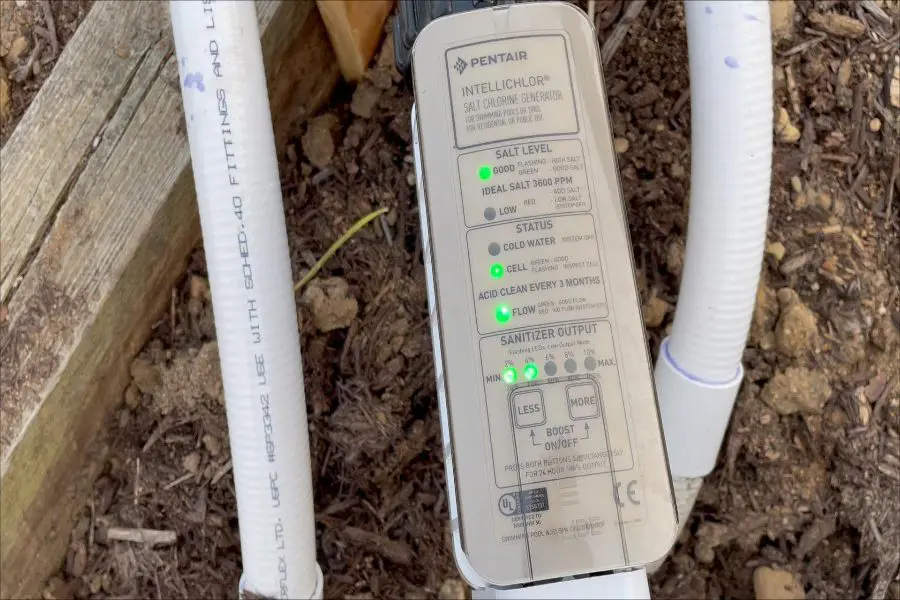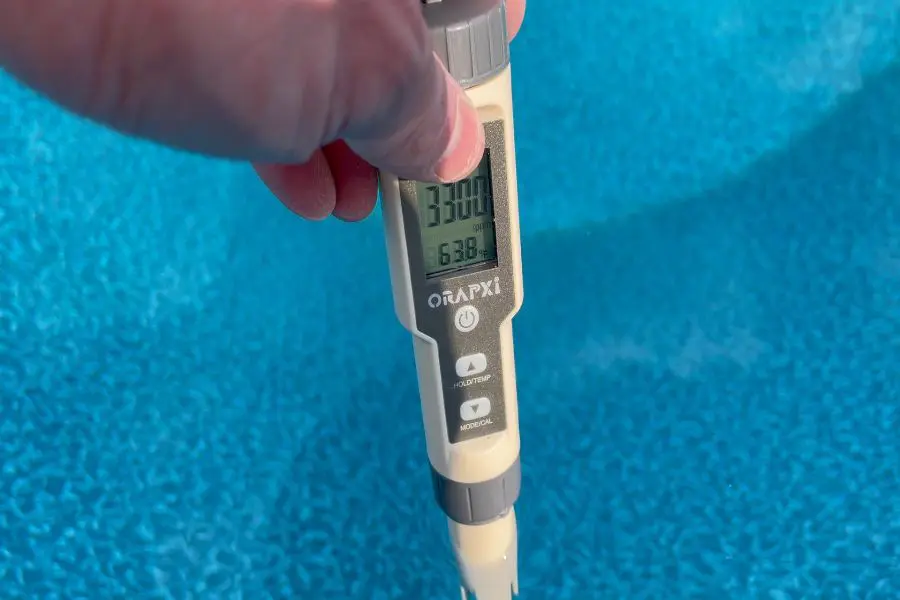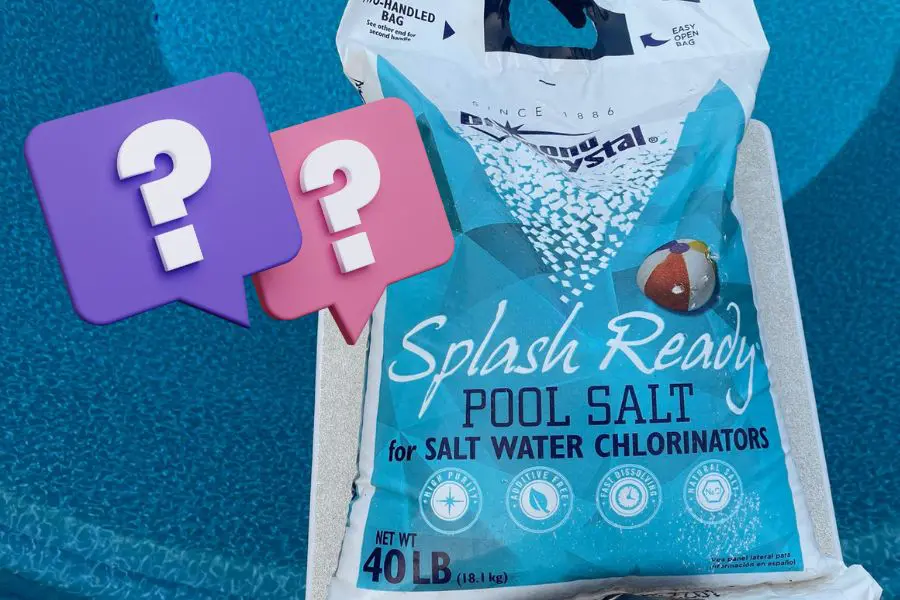With the cost of chlorine skyrocketing in recent years, many pool owners (including us) have decided to transition to saltwater pools. These pools use a saltwater chlorine generator (SWCG) to convert salt into chlorine and keep you pool from turning green.
Using a SWCG will allow you to ditch the traditional dichlor or trichlor products since you’ll be using the salt in the pool to create your own chlorine!
The SWCG essentially does all the work in maintaining a steady free chlorine level in the pool, while the salt provides silkier water for the swimmers. Unsurprisingly, when converting to a saltwater pool, you’ll need to add an initial dose of salt to the pool.
Knowing that the SWCG is converting that salt to chlorine, leads many to wonder “How much salt does a pool use per month?” In many cases the pool is not actually using up any of the salt, but that doesn’t mean that salt only needs to be added one initial time.
In this post, we’ll look at just how much salt you can expect a saltwater pool to use on a regular basis. This should give an idea of how much salt you’ll need to buy to keep it running at an optimal level.
How a Saltwater Chlorinator Works
Contrary to popular belief, saltwater pools aren’t entirely chlorine-free. Instead, the pools use an SWCG (salt cell) to generate chlorine.
As you may remember from high school chemistry, salt is a mineral that is primarily sodium chloride (NaCl). The pool’s circulation system sends water through the SWCG, where it uses low voltage electricity to split the chlorine (Cl) from the sodium (Na). The resulting chlorine gas dissolves into the water before returning to the pool.
Before using a SWCG, it is important that the salinity of the pool has been adjusted to the optimal level. Most salt chlorinators recommend between 2800 to 4000 ppm of salt in the water.
There are handy calculators available to indicate how much salt should be added. For a 20,000 gallon pool that has no initial salt level, it’s likely that upwards of 500 pounds of salt may be necessary to support the SWCG.
How Much Chlorine Does a Salt Chlorinator Produce

A salt chlorinator is designed to produce a certain quantity of chlorine each day, depending on how long it’s configured to run. It is important to select an appropriately sized SWCG unit that can accommodate the pool volume.
Our Pentair IC40 saltwater chlorinator (for pools up to 40,000 gallons) is rated to produce up to 1.4 lb of chlorine every 24 hours when running at 100%. Since we only run ours at 40% for 10 hours per day, this means ours is producing about ¼ lb per day.
Most manufacturers of the salt cell will provide the designed output to indicate how much chlorine production you can anticipate when using the unit. It’s recommended that you monitor the FC frequently during initial setup in order to determine the proper output settings.
How Much Salt Does a Pool Use Per Month?
Since the SWCG is converting salt into chlorine, many people may think they’ll need to routinely dump salt into the pool. However, this isn’t necessarily the case.
While the SWCG is splitting apart the chlorine from the sodium, once the chlorine has become expended in the pool it rejoins with the sodium. In essence, the salt regenerates in the water as the chlorine is used. There’s more science to this process that involves atoms and electrons, but we’ll spare ourselves from totally reliving chemistry class!
To circle back to the original question “How much salt does a pool use per month?” The answer is actually NONE, as it regenerates when the chlorine breaks down.
Once the initial salinity is achieved, the salt level should remain stable in the pool during normal use. The consistency of chlorine output from the SWCG without needing to add a sanitizer is one of the great benefits of a saltwater pool compared to standard chlorine.
Does Salt Evaporate from Pool?
Another misconception is that evaporation will remove salt. The opposite is actually true.
During evaporation only pure water is leaving the pool, which means the salt is left behind. As water evaporates, the salinity of the pool may actually increase since you’re left with a higher concentration of salt relative to the reduced pool volume.
Adding water to make up for the evaporation will help keep the salt concentration steady in the pool.
How Often to Add Salt to Pool
While there shouldn’t be a need to routinely add salt to the pool, there are some occasions where it is required.
Add Salt After Drain and Refill
When water from the pool is drained, the salt is also being drained simultaneously. This includes both partial draining (e.g., during winterization) and full draining for maintenance purposes.
After fresh water has been added to a drained pool, it’s important to measure the salinity levels using a test kit or a meter in order to calculate how much salt needs to be added. Many SWCG units also include indication of when the salt level is OK, but it’s best to double-check it against another means.
Add Salt to Pool After Rain
If a large amount of rain has fallen, it could dilute the salt concentration in the pool reducing effectiveness of the SWCG.
For instance, three inches of rain in a 600 square foot pool equates to around 1,100 gallons of freshwater that has been added. If the pool volume was initially 20,000 gallons, the 1,100 gallons of rain water could reduce the salinity by over 5%. In other words, salinity of 3500 ppm before the rainfall could be diluted down to 3300 ppm.
While one large downpour may not cause a huge sway in salt concentration, several of them could require addition of salt to restore the balance. If a dry stretch of weather occurs after the rain has fallen there’s potential to allow natural correction of the salt level through evaporation.
How Much Salt to Add to Pool After Rain
To determine how much salt to add to the pool after rain, you’ll need to measure the salt concentration. You can then compare the measured salt concentration against your target concentration.
Once you know how much the salt level needs to increase, you can perform a simple calculation to determine how much salt to add:
Pounds of Salt to Add per 10,000 Gallons = 8.375 x Salt Level Increase (ppm) ÷ 100
For example, if your target salt level is 3500 ppm, but a rainstorm has knocked it down to 3300 ppm, you’ll need to add enough salt to increase it by 200 ppm. For a 20,000 gallon pool, the equation above indicates that 32 pounds of salt is required.
How to Measure Salt Content in Pool

Regular monitoring of the salt level in the pool is essential to ensure the saltwater chlorinator is at optimal performance.
Most saltwater pool systems come equipped with a salt concentration sensor that indicates whether the salt level is adequate. Some systems simply use an indicator light to indicate whether the level is OK or not, while other systems may actually provide a numerical readout of the concentration.
If your SWCG does not have a numerical readout, you should consider purchasing a salt level test kit or a salinity meter. These will provide you with more specific values that can be used to help make adjustments to the salt level.
Final Takeaway
Saltwater pools are often a great alternative to traditional chlorinated pools. Once you have established the initial salt level in the pool, the SWCG will do the rest of the work in converting it into chlorine.
And, while the SWCG is using salt to generate chlorine, the salt will still regenerate itself as the chlorine breaks down in the water. This means that under normal use the pool does not use up any salt.
The two main times when you’ll need to consider adding salt is if you’ve drained water from the pool or after heavy rainfall. In either case, it’s recommended you measure the salt concentration (ppm) in the pool to calculate the amount of salt needed to re-establish your target level.
Keeping your salt level at an appropriate level will not only ensure adequate chlorine levels, but will also help your pool from tasting too salty.
Happy Swimming!
Husband and father of three (actually, four if you include the pool). I’m an avid DIY-er and weekend warrior that enjoys taking up new projects around the house to help us maximize leisure right at home. I enjoy researching and sharing various tips, tricks and knowledge to help others make their home an oasis.

